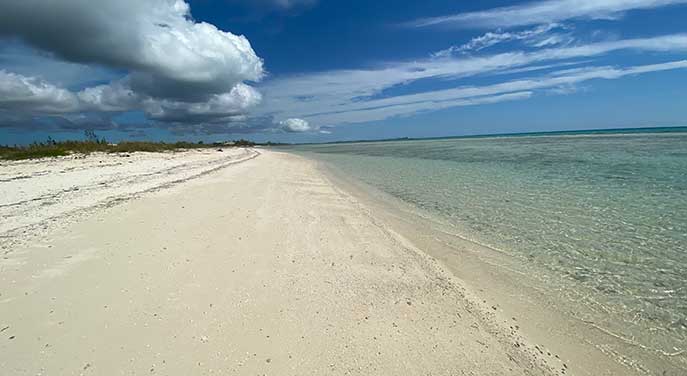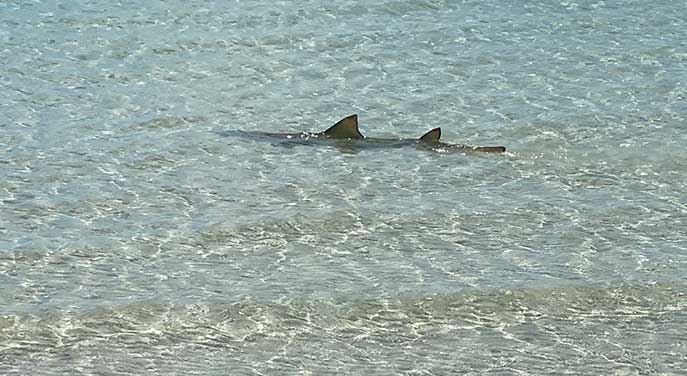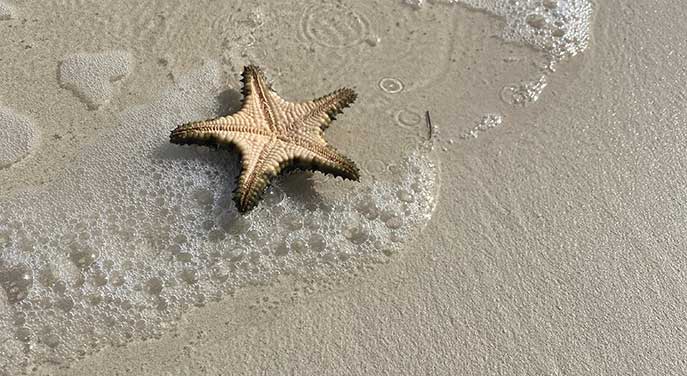
Ah, the beaches. Photo by Kerry Diotte for Troy Media
 FREEPORT, Bahamas – You never get a second chance to make a first impression. That’s a bit of a trite yet true sentiment.
FREEPORT, Bahamas – You never get a second chance to make a first impression. That’s a bit of a trite yet true sentiment.
Travellers have all had their fair share of nasty, cantankerous customs officials.
I know I have. So that’s why my very first impression of The Bahamas was a favourable one. The Bahamian official who waved my wife Clare and me through at customs at Lynden Pindling International Airport in Nassau was friendly AND smiling.
“Welcome to The Bahamas. Have a nice stay,” he bellowed, accompanied by a friendly wave.
It was just a hint of the kind of warmth we felt from virtually every official and person we encountered in this chain of 700 islands north of Cuba and east of the U.S. state of Florida.
This English-speaking country, officially known as the Commonwealth of the Bahamas, within the Lucayan Archipelago of the West Indies, gained its independence from Britain in 1973.
It has a rich history – punctuated by periods of piracy and slavery – having been inhabited by the Lucayan people for centuries before Christopher Columbus became the first European to land here in 1492.
The most populous and developed island is New Providence, where the capital of Nassau is located. We flew there via Toronto, Ont. before taking another brief flight to Grand Bahama, where we stayed at a private residence near Freeport.

You may even see the occasional shark. Photo by Kerry Diotte for Troy Media
But wherever we walked – whether on deserted beaches or beside low-traffic streets – almost all the people we encountered smiled and said hi. It’s not unlike what you’d experience growing up in a small town.
The next phenomenon that quickly becomes obvious to a visitor is that this island nation is still etched with the deep scars – both literally and figuratively – inflicted by Hurricane Dorian in September 2019.
It was a Category 5 beast that packed winds as high as 295 kmh. The eye of the hurricane stalled over parts of The Bahamas for one full day and unleashed a torrent of death and destruction. It left 70,000 homeless.
According www.reliefweb.int, the official death toll was 74, with 282 people still unaccounted for. The government estimates that Dorian caused $3.4 billion in “loss and damages.”
Just seeing whole sections of trees stripped bare – many snapped in half – gave a window into the horrendous power this storm packed. Wherever we went on Grand Bahama, we saw more evidence. There are houses levelled to rubble and structures of all sizes that were never repaired or not fully restored.

… or shellfish, if you’re lucky. Photo by Kerry Diotte for Troy Media
It’s a reminder that as resilient as this nation is, Dorian still casts a shadow over this part of the world. The economy, much of it dependent on tourism, has never fully recovered. Like much of the world, tourism here is also ever-so-slowly recovering from the ill effects of COVID on the travel industry.
We experienced first-hand the first hint of Dorian’s lingering effect on Grand Bahama on arrival at the international airport.
The buildings are still damaged, so much so that arriving passengers wait outdoors under an awning for luggage that’s brought out in the back of a pickup truck and then set down on the ground. No biggie, really. At least the luggage got to us fairly quickly.
It was just a hint that tourism here – especially on Grand Bahama Island – is still in recovery mode.
But we saw that as an advantage. We spent most of our days here on glorious white sand beaches framed by unbelievably crystal clear water – scenery you thought only existed in the edited ‘reality’ of Photoshopped travel brochure photos.
We spent much of our time chilling on Fortune Beach, where you can wade for hundreds of metres in the sparkling, clear water. If you’re fortunate, as we were, you’ll see the odd curious stingray or a small harmless nurse shark.
How quiet can it be in Grand Bahamas? Plenty quiet. One day we spent seven hours on Fortune Beach and encountered a grand total of three humans. That’s the kind of solitude you can’t find at many other destinations.
When we spent time there in February we walked past the posh, sprawling Viva Wyndham resort and it seemed there were more staff members than guests.
If we did want to socialize just a bit, we were within walking distance to Banana Bay restaurant, a beachfront haunt that features burgers, fish, salad, conch and cold drinks. Further down, past the Wyndham resort, was our favourite quirky local watering hole named Margarita Villa Sand Bar. It’s aptly named because tables and chairs inside sit right on that beautiful, powdery white sand.
Given the rare opportunity for such peace and quiet, we chose to stay mainly on our favourite beach, Fortune Beach, where you can swim, snorkel and collect your fill of seashells.
Generally speaking, Grand Bahama Island is much quieter than Paradise Island where Nassau is located. Paradise Island has 70 per cent of the population of The Bahamas.
However, there are numerous attractions on Grand Bahama Island, including opportunities to snorkel, scuba dive, go zip lining, shop and tour a local brewery.
Given that COVID has had a significant effect on tourism, the best advice is to call or e-mail any of these attractions ahead of time. Some might still be closed. Some may have permanently closed. Still others might have reduced hours of operation.
This is the “price” you pay for the kind of solitude you’ll find on Grand Bahama Island. In my book, it’s a price well worth paying for a rare experience.
QUICK TIPS:
For a good summary of the island highlights, click here.
Prices on meals, drinks and accommodations are higher than in Canada, so budget accordingly. The website budgetyourtrip.com reports that the average hotel price is $199 a night, although there are more affordable accommodations on airbnb.ca and vrbo.com.
You’ll be using Bahamian dollars there that are equivalent to U.S. dollars. When merchants give change, you’ll often get a mixture of both currencies.
Check rules surrounding COVID testing. When we travelled, we needed to produce a negative antigen test upon arrival and then get re-tested in two days. We had to fill in a Travel Health Visa in advance with our test results and pay $40 US. Go to bahamas.com to get the most up-to-date information.
Kerry Diotte is a veteran journalist who has worked for newspapers and magazines and in radio and television. To contact Kerry to book him for your destination, click here.
The opinions expressed by our columnists and contributors are theirs alone and do not inherently or expressly reflect the views of our publication.
© Troy Media
Troy Media is an editorial content provider to media outlets and its own hosted community news outlets across Canada.


